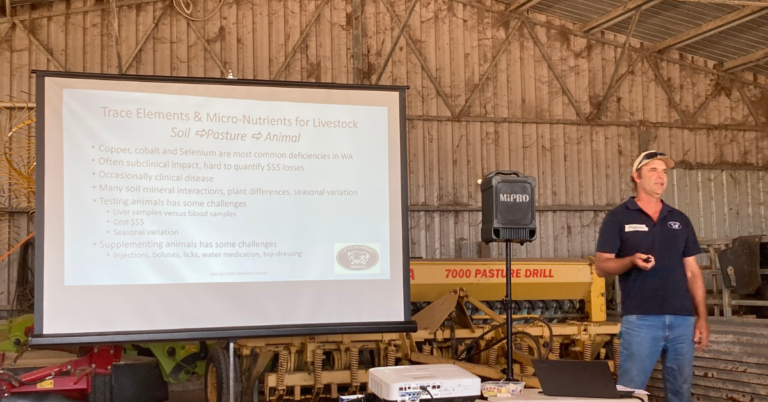
Veterinarian Ian Bradshaw.
Plant tissue testing can be critically important for managing both pasture nutrition and ruminant health.
With plant nutrition, tissue tests are a more reliable method for confirming trace element deficiencies compared to soil tests (reference) because the amounts needed by plants are so small.
Yet trace elements can have major impacts on ruminant health.
The best time for tissue testing is early spring when plants are actively growing. So, let’s explain why you should consider tissue testing pastures during September.
Molybdenum induced copper deficiency
Molybdenum is commonly referred to as moly. Worth noting: Moly isn’t part of a “standard” CSBP lab tissue test and needs to be requested in a “comprehensive” test.
Moly is required in plants for protein synthesis and plays a vital role in helping legumes like clover fix nitrogen. However, in livestock, too much moly can form complexes called thiomolybdates in the rumen that bind copper and may induce copper deficiency that is irreversible.
The key here is balance!
To understand more on this topic, South West NRM engaged local vet Ian Bradshaw during our 2023 Pasture Challenge project. He explained that levels of trace elements required by plants and animals can differ.
“Plants need about 4 mg/kg of copper. For cows and calves, you need to feed about 10 mg/kg,” he said.
“You can get away with a bit less if everything else is good.”
And when he says, “everything else,” he means the levels of moly and other elements like sulfur, zinc and iron.
“Moly is considered adequate for plants within a range of 500-1,500 μg/kg. However, as moly increases above 2,000 μg/kg, it starts to have significant interactions with copper availability.
“The extent of this interaction can depend on the level of other elements, especially sulfur and iron.”
“Sulfur over 0.25% starts to run the risk of copper deficiency, even though that level is ideal for plants,” he said.
“Iron over 250mg/kg starts to have a significant impact as well.
How common is excess moly?
Back in 2019, South West NRM undertook sub clover tissue tests at 37 sites across 21 high rainfall livestock farms.
Results for moly showed that only 19% of sites were within the range adequate for plants!
Typically, moly levels were low, with 62% below 500 μg/kg. But a significant 19% were above 1,500 μg/kg. In one of the worst cases, two sites on the same farm were almost 4 x above the recommended levels! All landholders were blissfully unaware of their risks with copper deficiency.
The lime effect
A critical factor in the management of moly is its interaction with lime used to increase soil pH.
As the pH of acidic soils increases, so does the availability of moly and most macronutrients.
Conversely, the availability of other trace elements including copper, zinc and manganese declines.
This lime effect was demonstrated in our Pasture Challenge project.
The table below compares tissue test results for plots where lime was incorporated into the soil versus those that weren’t limed.
September results suggested that incorporating lime to increase soil pH response may have also increased the rate at which moly availability increased.
By September, the average moly level where lime was incorporated had increased dramatically to over 4,000 μg/kg.
Name | Copper | Zinc | Manganese | Molybdenum |
| mg/kg | mg/kg | mg/kg | µg/kg |
Limed (5T/ha) | 6.1 | 30.8 | 33.9 | 2,936 |
No lime | 7.7 | 32.5 | 50.6 | 1,942 |
Table. Affect of lime on selected trace element availability. Results are for ryegrass plant tissue sampled and compare average of two plots with 5 T/ha of lime incorporated into the soil with two adjacent unlimed plots. NOTE: copper was sprayed on unlimed plots in May.
The need for moly, combined with the risks of inducing copper deficiency suggest that tissue testing pastures for trace element status every 3-5 years is vital, especially if you are thinking of liming paddocks which may increase availability of moly and reduce copper.
If moly is already high, it may be worth seeking agronomic or animal health advice and potentially applying copper or limiting the application of sulfur in the same season.
It’s important to note that avoiding the use of lime is not a sustainable response to the risk of copper deficiency.
Liming to raise soil pH above 5 can increase the activity and carbon use efficiency of soil biology and increase the availability of other nutrients, while potentially reducing the availability of aluminium and the impact of disease in legume roots.
For more information on tissue testing, check out our other case study: Three ways tissue testing helps.
